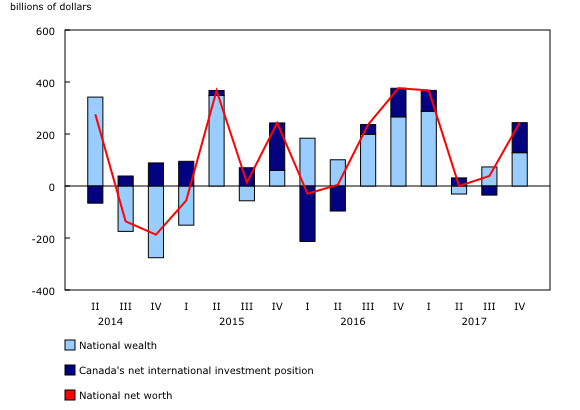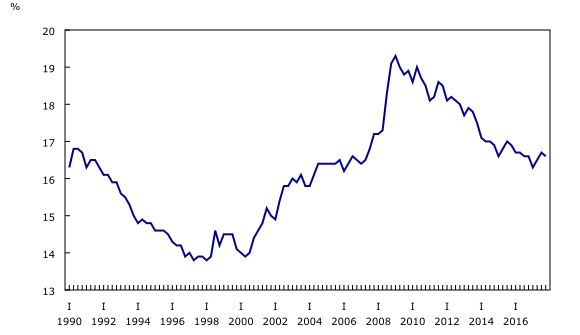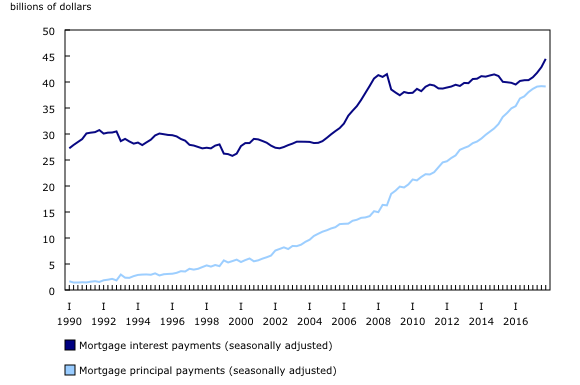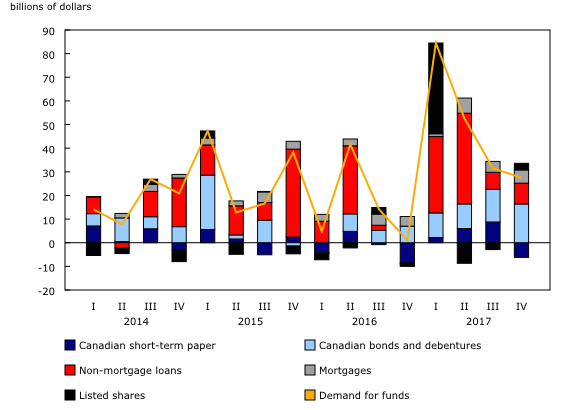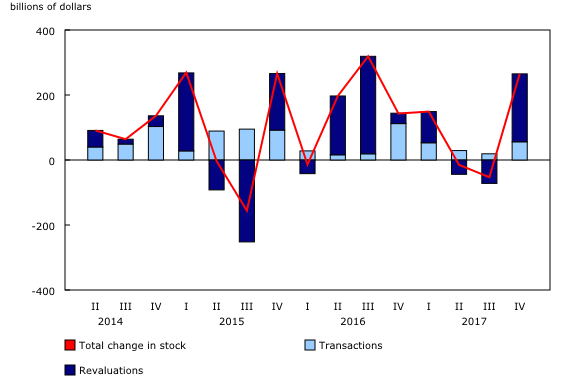National balance sheet and financial flow accounts, fourth quarter 2017
Archived Content
Information identified as archived is provided for reference, research or recordkeeping purposes. It is not subject to the Government of Canada Web Standards and has not been altered or updated since it was archived. Please "contact us" to request a format other than those available.
Released: 2018-03-15
National wealth increases for the second consecutive quarter
National wealth, the value of non-financial assets in the Canadian economy, rose 1.2% to $10,769.0 billion at the end of the fourth quarter, led by growth in the value of residential and commercial structures.
Canada's net foreign asset position rose by $115.4 billion to $400.7 billion in the fourth quarter. Compared with the end of 2016, the net asset position nearly doubled in 2017 on the strength of foreign stock markets.
National net worth, the sum of national wealth and Canada's net foreign asset position, increased by $243.5 billion to $11,169.7 billion at the end of the fourth quarter. On a per capita basis, national net worth increased from $296,200 in the third quarter to $302,300 in the fourth quarter.
Rising household sector net worth fueled by strong equity markets
The net worth of the household sector increased 2.1% in the fourth quarter, to $10,889.6 billion. Financial assets were the main contributor, growing by $196.6 billion to $6,876.0 billion, led by equity and investment funds (+$110.5 billion) as domestic and foreign markets ended the year on a strong note. Similarly, life insurance and pension assets benefited from strong equity markets, rising $68.4 billion in the fourth quarter.
Growth in the value of household residential real estate continued to be relatively weak, increasing by 0.6% in the fourth quarter, after remaining flat in the previous two quarters. Year over year, the value of residential real estate was up 3.4% in 2017. This was the smallest annual increase since 2009 and well below the 8.1% gain recorded in 2016, as residential real estate prices moderated throughout the year.
Total household credit market debt (consumer credit, mortgage and non-mortgage loans) reached $2,131.3 billion following a 1.1% increase in the fourth quarter. Mortgage debt reached $1,397.0 billion, while consumer credit rose to $630.4 billion. On a year-over-year basis, consumer credit increased 5.3% in 2017 compared with 3.9% in 2016. Mortgage debt increased 4.9% in 2017, compared with 6.0% annual growth in 2016.
Household credit market debt as a proportion of household disposable income (adjusted to exclude pension entitlements) remained relatively unchanged at 170.4% in the fourth quarter, compared with 170.5% in the previous quarter. In other words, there was $1.70 in credit market debt for every dollar of household disposable income. Leverage, measured by the ratio of household total debt to total assets, declined slightly from 16.7% to 16.6% at the end of the fourth quarter, as total assets grew at a faster pace (+1.9%) than the value of total debt (+1.1%). This continued a general downward trend that began in the fourth quarter of 2008.
Mortgage borrowing up in the fourth quarter
On a seasonally adjusted basis, households increased their credit market debt by $26.0 billion in the fourth quarter, up from $23.5 billion of borrowing in the previous quarter. Seasonally adjusted mortgage borrowing was up 4.1% from the third quarter to $16.0 billion, the first increase after five consecutive quarterly decreases. New mortgage rules came into effect in the first quarter of 2018.
The total household debt service ratio, measured as total obligated payments of principal and interest as a proportion of household disposable income for both mortgage and non-mortgage debt, remained flat at 13.8% in the fourth quarter. The share of mortgage interest payments increased in the quarter, relative to obligated payments of mortgage principal after recent interest rate hikes.
Federal government net debt position improves
Federal government demand for funds declined for the second consecutive quarter with a net issuance of $14.5 billion of Canadian bonds, which was offset by $14.9 billion in net retirements of short-term paper. The demand for funds by other levels of governments was $3.6 billion, the lowest level since the third quarter of 2015. Net issuances of bonds and debentures by other levels of government was $1.6 billion in the fourth quarter, the lowest level since the second quarter of 2008.
The ratio of federal government net debt (book value) to gross domestic product (GDP) declined from 29.1% at the end of the third quarter to 28.9% at the end of the fourth quarter. The ratio of other government net debt (book value) to GDP remained flat at 27.4%, as GDP grew at a similar pace to government net debt (book value).
Demand for funds by non-financial private corporations remains flat
The demand for funds by non-financial private corporations began tapering off at the end of 2017, declining to $27.5 billion, after strong mergers and acquisitions activity and other borrowing in the first half of the year. Despite this deceleration, demand for funds for 2017 as a whole was $196.1 billion, higher than 2016 ($61.7 billion) and 2015 ($114.8 billion). The composition of borrowing on financial markets marked a shift from short term to long term instruments in the fourth quarter, as non-financial corporations recorded $6.2 billion in net retirements of short term paper and $16.4 billion in net issuances of bonds.
Value of financial corporations' financial assets up significantly
The financial sector provided $30.9 billion of funds to the economy through financial market instruments in the fourth quarter, an increase from the previous quarter's value of $17.6 billion. This additional lending was attributable to increases in several instruments, including non-mortgage loans (+$8.0 billion), listed shares (+$7.7 billion) and bonds (+$10.4 billion), which together more than offset decreases in consumer credit (-$0.4 billion), short-term paper (-$8.2 billion) and mortgages (-$4.2 billion).
The value of financial corporations' total financial assets grew by $324.5 billion to reach $13,821.6 billion at the end of the fourth quarter, led by gains of the banking sector and institutional investors. The other changes in assets accounts, which record changes in the value of assets and liabilities caused mainly by revaluations due to asset price changes, recorded an increase in value of financial assets of $207.3 billion. The main contributors to this upward revaluation were Canadian bonds and debentures (+$16.1 billion), listed shares (+$59.3 billion), unlisted shares (+$41.8 billion) and foreign equity investments (+$72.6 billion), which mainly increased as a result of appreciating asset prices.
Note to readers
This release of the financial and wealth accounts is comprised of the national balance sheet accounts (NBSA), financial flow accounts (FFA) and other changes in assets accounts (OCAA).
The NBSA are composed of the balance sheets of all sectors and subsectors of the economy. The main sectors are households, non-profit institutions serving households, financial corporations, non-financial corporations, government, and non-residents. The NBSA cover all national non-financial assets and financial asset-liability claims outstanding in all sectors. To improve the interpretability of the estimates of the financial flows, selected household borrowing series are available on a seasonally adjusted basis (CANSIM table 378-0127). All other data are unadjusted for seasonal variation. For information on seasonal adjustment, see Seasonally adjusted data – Frequently asked questions.
The FFA articulate net lending or borrowing activity by sector by measuring financial transactions in the economy. The FFA arrive at a measure of net financial investment, which is the difference between transactions in financial assets and liabilities (for example, net purchases of securities less net issuances of securities). The FFA also provide the link between financial and non-financial activity in the economy, which ties estimates of saving and non-financial capital acquisition (for example, investment in new housing) to the underlying financial transactions.
While the financial flow accounts record changes in financial assets and liabilities between opening and closing balance sheets that are associated with transactions during the accounting period, the value of assets and liabilities held by an institutional unit can also change for other reasons. These other types of changes, referred to as other economic flows, are recorded in the other changes in assets account.
There are two main components to this account. One is the other changes in the volume of assets account. This account includes changes in non-financial and financial assets and liabilities relating to the economic appearance and disappearance of assets, the effects of external events such as wars or catastrophes on the value of assets, and changes in the classification and structure of assets. The other main component is the revaluation account, showing holding gains or losses accruing to the owners of non-financial and financial assets and liabilities during the accounting period as a result of changes in market price valuations.
At present, only the aggregate other change in assets is available within the Canadian System of Macroeconomic Accounts; no details are available on the different components.
Definitions concerning financial indicators can be found in Financial indicators from the National Balance Sheet Accounts in the System of macroeconomic accounts glossary.
Revisions
This fourth quarter release of the national balance sheet and financial flow accounts includes revised data from the first quarter of 2017 through the third quarter of 2017. These data incorporate new and revised data, as well as updated data on seasonal trends.
In the near future, data enhancements to the national balance sheet and financial flow accounts will be incorporated, such as the development of detailed counterparty information by sector. In order to facilitate this initiative and others, it will be necessary to extend the annual revision period (normally the previous three years) at the time of the third quarter release. As such, for the next three years, with the third quarter release, the data will be revised back to 1990 to ensure a continuous time series.
Next release
Data on the national balance sheet and financial flow accounts for the first quarter of 2018 will be released on June 14.
Products
The document "Understanding Household credit measures, a joint study by the Bank of Canada and Statistics Canada," which is part of Latest Developments in the Canadian Economic Accounts (13-605-X), is available.
The User Guide: Canadian System of Macroeconomic Accounts (13-606-G) is available.
The Methodological Guide: Canadian System of Macroeconomic Accounts (13-607-X) is available.
The System of Macroeconomic Accounts module features an up-to-date portrait of national and provincial economies and their structure.
Contact information
For more information, or to enquire about the concepts, methods or data quality of this release, contact us (toll-free 1-800-263-1136; 514-283-8300; STATCAN.infostats-infostats.STATCAN@canada.ca) or Media Relations (613-951-4636; STATCAN.mediahotline-ligneinfomedias.STATCAN@canada.ca).
- Date modified:



